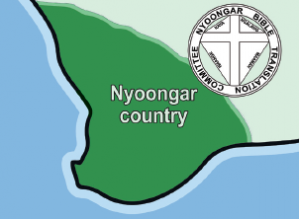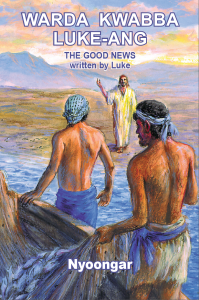In Perth’s grand Anglican Cathedral on Sunday came the voices of a choir singing, “Ngala boorda yanganan Birdiyar” – “We praise the Lord”. It’s the first phrase of Luke 1:68 in the Nyoongar language, the beginning of the ‘Benedictus’ or ‘Zechariah’s song’. The service was a celebration, an acknowledgement that, for the first time, the Nyoongar people of Australia’s south-west have part of the Bible in their own language.
 There were several milestones in the service of praise and thanksgiving. When the Gospel was read in Nyoongar, it was the first time that the Gospel had been read in an Aboriginal language in an Anglican Church in Western Australia. When the choir sang the Benedictus in Nyoongar, it was the first time ever anywhere in Australia that an Anglican canticle (chant) had been sung in an Aboriginal language.
There were several milestones in the service of praise and thanksgiving. When the Gospel was read in Nyoongar, it was the first time that the Gospel had been read in an Aboriginal language in an Anglican Church in Western Australia. When the choir sang the Benedictus in Nyoongar, it was the first time ever anywhere in Australia that an Anglican canticle (chant) had been sung in an Aboriginal language.
Nyoongar is an Aboriginal word meaning originally meaning ‘man’ or ‘male’. When white people first arrived in Western Australia, they quickly learned the word and used it generally to speak of the Aboriginal people they came across. Now, it is the name used for the Indigenous people of south-west Australia, some 30,000 strong.
For 15 years, a group of volunteer translators, initiated by Lorna Little and Vivienne Sahanna, both Nyoongar women, have been translating the Gospel of Luke. On Sunday, the completed translation was celebrated in Perth’s St George’s Anglican Cathedral.
“It was a fantastic celebration,” said Tom Little, one of the volunteer translators involved in the project since 2003. A Nyoongar man himself, Tom is the son of Lorna Little, who with her sister Vivienne approached Bible Society with an idea: they wanted the Scriptures in their own language.
 For Tom, the Nyoongar translation is very much a family affair. Parents, uncles, aunts and siblings have all worked as volunteer translators. With the help of Rev Dr John Harris, a Bible Society translation consultant and Indigenous linguist, Tom’s family drove the Nyoongar Gospel of Luke project to completion.
For Tom, the Nyoongar translation is very much a family affair. Parents, uncles, aunts and siblings have all worked as volunteer translators. With the help of Rev Dr John Harris, a Bible Society translation consultant and Indigenous linguist, Tom’s family drove the Nyoongar Gospel of Luke project to completion.
John, who has been involved in a dozen or more Indigenous Bible translations in his life-long dedication to translation work, says the completion of the first scriptures in the Nyoongar language is hugely important.
“Even though most of the Nyoongar people – or all – are probably capable of reading English, it’s not the language to which their emotions and their feelings and identity are attached. Even those who don’t speak Nyoongar very well will feel that they are Nyoongar people, not English-speaking people,” said John.
“And what you have to realise about the English Bible, even though the Nyoongar people can read and perhaps understand the text, that it’s in the language of the conquerer, the language of the invader.”
Tom says having the Gospel of Luke in Nyoongar gives him a greater sense of ownership of the message of the gospel. “It’s in our language. I see it and I say, ‘That’s my language, and it’s the gospel’. There’s a greater involvement in the gospel when you can learn and read it in your own language. There’s hidden shades of meaning from the English version that having the gospel in Nyoongar really brings out for me.”
The Cathedral’s celebrations including choir singing, Bible readings and prayers all in the Nyoongar language. “The very fact of hearing my own language as scripture, and as music, was absolutely sensational,” says Tom.
When Vivienne and Lorna came to Bible Society to ask for help in translating the scriptures, they first asked for the Lord’s Prayer. Once that was completed, Vivienne took copies of it on little cards into a local prison, where she visited the many Aboriginal inmates. John Harris recalls the story she told him.
“She told me that there are angry men in the gaol who would never talk to a Christian about Christian things. But she said they all took a copy of the Lord’s Prayer in Nyoongar.” That was, in part, because of the rarity of finding written materials in their own language. But also, says John, because the Lord’s Prayer in Nyoongar was a symbol of respect for their language.
“It told them their language was real, that it mattered. And the Lord’s Prayer in Nyoongar also said, ‘God speaks your language’. That’s something that’s very common for people to say when they get the scriptures for the first time: ‘Now I know that God speaks my language.’”
John says in some ways Bible translation is more important to people who are conscious that they are losing their language.
Many Indigenous languages have disappeared. From the 500 Aboriginal languages documented at European invasion, there are probably 50, says John, that are spoken today. Bible Society and other Christian organisations have worked on translating some part of the Bible in around 40 of those languages. But John predicts that only 12 Aboriginal languages will survive this century.
“In some of these languages that have disappeared, or are disappearing, the only proper text they have, in full sentences and connected paragraphs, is a Bible or a gospel portion. People from universities studying linguistics, and Aboriginal people who want to learn about their own language, will often ask us to reprint those scriptures for them, so they can have an example of how their language was spoken.
“So, contrary to what many in the community sometimes think about missionaries being anti-cultural and destructive—and some were—the act of translating the scriptures is a very honouring thing. To take the thing that is most precious to you in the whole world, and work to put that into an Aboriginal language, and spend your whole life doing it, is very respectful, I think.”
Email This Story
Why not send this to a friend?

